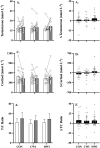Effect of repeated post-resistance exercise cold or hot water immersion on in-season inflammatory responses in academy rugby players: a randomised controlled cross-over design
- PMID: 38613679
- PMCID: PMC11365841
- DOI: 10.1007/s00421-024-05424-3
Effect of repeated post-resistance exercise cold or hot water immersion on in-season inflammatory responses in academy rugby players: a randomised controlled cross-over design
Abstract
Purpose: Uncertainty exists if post-resistance exercise hydrotherapy attenuates chronic inflammatory and hormone responses. The effects of repeated post-resistance exercise water immersion on inflammatory and hormone responses in athletes were investigated.
Methods: Male, academy Super Rugby players (n = 18, 19.9 ± 1.5 y, 1.85 ± 0.06 m, 98.3 ± 10.7 kg) participated in a 12-week programme divided into 3 4-week blocks of post-resistance exercise water immersion (either, no immersion control [CON]; cold [CWI]; or hot [HWI] water immersion), utilising a randomised cross-over pre-post design. Fasted, morning blood measures were collected prior to commencement of first intervention block, and every fourth week thereafter. Linear mixed-effects models were used to analyse main (treatment, time) and interaction effects.
Results: Repeated CWI (p = 0.025, g = 0.05) and HWI (p < 0.001, g = 0.62) reduced creatine kinase (CK), compared to CON. HWI decreased (p = 0.013, g = 0.59) interleukin (IL)-1ra, compared to CON. HWI increased (p < 0.001-0.026, g = 0.06-0.17) growth factors (PDGF-BB, IGF-1), compared to CON and CWI. CWI increased (p = 0.004, g = 0.46) heat shock protein-72 (HSP-72), compared to HWI.
Conclusion: Post-resistance exercise CWI or HWI resulted in trivial and moderate reductions in CK, respectively, which may be partly due to hydrostatic effects of water immersion. Post-resistance exercise HWI moderately decreased IL-1ra, which may be associated with post-resistance exercise skeletal muscle inflammation influencing chronic resistance exercise adaptive responses. Following post-resistance exercise water immersion, CWI increased HSP-72 suggesting a thermoregulatory response indicating improved adaptive inflammatory responses to temperature changes, while HWI increased growth factors (PDGF-BB, IGF-1) indicating different systematic signalling pathway activation. Our data supports the continued use of post-resistance exercise water immersion recovery strategies of any temperature during in-season competition phases for improved inflammatory adaptive responses in athletes.
Keywords: Hydrotherapy; Inflammation; Recovery; Strength training; Team sports.
© 2024. The Author(s).
Conflict of interest statement
The authors have no competing interests to declare that are relevant to the content of this article.
Figures






References
-
- Aguiar PF, Magalhães SM, Fonseca IAT, da Costa Santos VB, de Matos MA, Peixoto MFD, Nakamura FY, Crandall C, Araújo HN, Silveira LR (2016) Post-exercise cold water immersion does not alter high intensity interval training-induced exercise performance and Hsp72 responses, but enhances mitochondrial markers. Cell Stress Chaperones 21(5):1–12 10.1007/s12192-016-0704-6 - DOI - PMC - PubMed
-
- Bonde-Petersen F, Schultz-Pedersen L, Dragsted N (1992) Peripheral and central blood flow in man during cold, thermoneutral, and hot water immersion. Aviat Space Environ Med 63(5):346–350 - PubMed
-
- Burke L (2015) Dietary assessment methods for the athlete: Pros and cons of different methods. Sports Sci Exch 28(150):1–6
Publication types
MeSH terms
Substances
LinkOut - more resources
Full Text Sources
Research Materials
Miscellaneous

